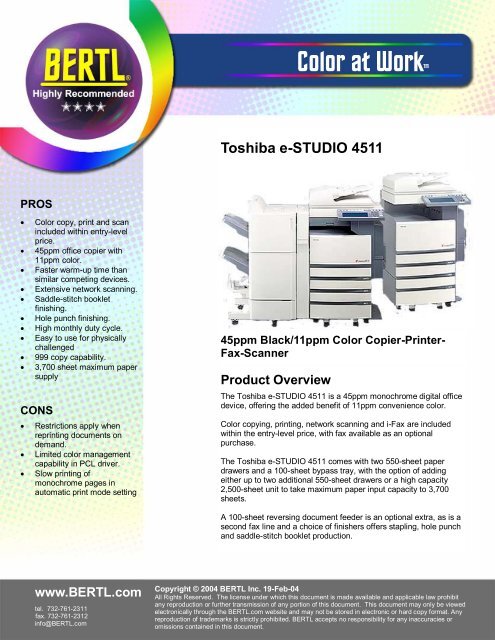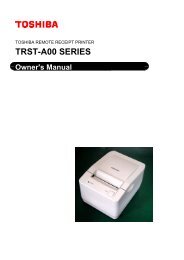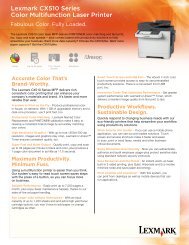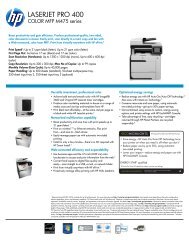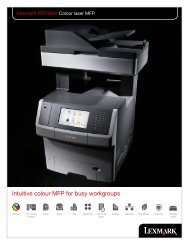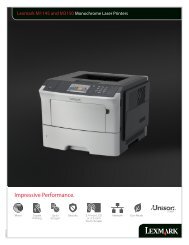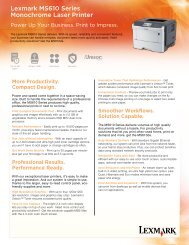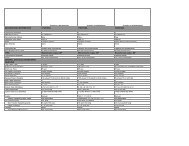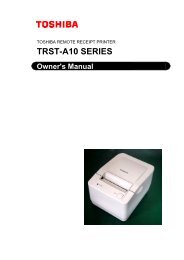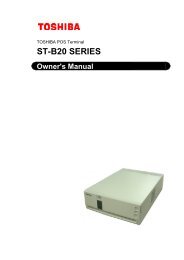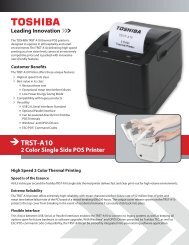Toshiba e-STUDIO 4511
Toshiba e-STUDIO 4511
Toshiba e-STUDIO 4511
Create successful ePaper yourself
Turn your PDF publications into a flip-book with our unique Google optimized e-Paper software.
Color at WorkTM<strong>Toshiba</strong> e-<strong>STUDIO</strong> <strong>4511</strong>PROS• Color copy, print and scanincluded within entry-levelprice.• 45ppm office copier with11ppm color.• Faster warm-up time thansimilar competing devices.• Extensive network scanning.• Saddle-stitch bookletfinishing.• Hole punch finishing.• High monthly duty cycle.• Easy to use for physicallychallenged• 999 copy capability.• 3,700 sheet maximum papersupplyCONS• Restrictions apply whenreprinting documents ondemand.• Limited color managementcapability in PCL driver.• Slow printing ofmonochrome pages inautomatic print mode setting45ppm Black/11ppm Color Copier-Printer-Fax-ScannerProduct OverviewThe <strong>Toshiba</strong> e-<strong>STUDIO</strong> <strong>4511</strong> is a 45ppm monochrome digital officedevice, offering the added benefit of 11ppm convenience color.Color copying, printing, network scanning and i-Fax are includedwithin the entry-level price, with fax available as an optionalpurchase.The <strong>Toshiba</strong> e-<strong>STUDIO</strong> <strong>4511</strong> comes with two 550-sheet paperdrawers and a 100-sheet bypass tray, with the option of addingeither up to two additional 550-sheet drawers or a high capacity2,500-sheet unit to take maximum paper input capacity to 3,700sheets.A 100-sheet reversing document feeder is an optional extra, as is asecond fax line and a choice of finishers offers stapling, hole punchand saddle-stitch booklet production.www.BERTL.comtel. 732-761-2311fax. 732-761-2312info@BERTL.comCopyright © 2004 BERTL Inc. 19-Feb-04All Rights Reserved. The license under which this document is made available and applicable law prohibitany reproduction or further transmission of any portion of this document. This document may only be viewedelectronically through the BERTL.com website and may not be stored in electronic or hard copy format. Anyreproduction of trademarks is strictly prohibited. BERTL accepts no responsibility for any inaccuracies oromissions contained in this document.
<strong>Toshiba</strong> e-<strong>STUDIO</strong> <strong>4511</strong>Color at Work tmProduct DynamicsBERTL Ratings & Awards on Copiers, Printers, Fax, MFPs andColor Devices are based on rigorous analysis and feedbackfrom buyers, users and service providers.Color capable black copier-printer MFP’shave been around for several years but<strong>Toshiba</strong>’s e-<strong>STUDIO</strong> <strong>4511</strong> is the fastest andmost integrated unit to hit the market at thetime of this report.While alternative offerings deliver reasonablefunctionality, the <strong>Toshiba</strong> e-<strong>STUDIO</strong> <strong>4511</strong> isthe first to convert a fully loadedmonochrome MFP into a color capablesystem. For example, the device offers:• Monochrome style warm up speed(s).• Mid range office speed (45ppm).• Monochrome MFP friendly cost(s).• Saddle stitch finishing.• In-line hole punching.• Monochrome MFP volume capabilities.• Standard print and scan.• Automatic booklet making.• Section 508/Disabled access features.• Store print and copy jobs for re-print ondemand.• And more….The <strong>Toshiba</strong> e-<strong>STUDIO</strong> <strong>4511</strong> will be soldalongside <strong>Toshiba</strong>’s monochrome-only45ppm digital MFP, offering buyers theadded capability of color for a fraction oftraditional color costs.The good news is that the <strong>Toshiba</strong>e-<strong>STUDIO</strong> <strong>4511</strong> does not force buyers tosacrifice monthly volume capability orfunctionality to gain color capability.The <strong>Toshiba</strong> e-<strong>STUDIO</strong> <strong>4511</strong> is sold as amultifunctional unit, delivering copy, print andnetwork scanning capabilities within its entrylevelprice. This means that to compareprices you must add these options tocompeting units or monochrome devices.Four Color PassOutput:The <strong>Toshiba</strong> e-<strong>STUDIO</strong> <strong>4511</strong>prints via a fourpasssystem. Thismeans that thetransfer belt makesfour passes overthe imaging drumsto create a full-colorpage.Hence, the speed of the <strong>Toshiba</strong> e-<strong>STUDIO</strong><strong>4511</strong> is faster in monochrome than color. Inmonochrome, the transfer belt is passedonce over the drum to deposit the blackimage, versus having to make fourrevolutions to create color output.150,000 Page Per Month MaximumVolume?Good news for office buyers, the <strong>Toshiba</strong>e-<strong>STUDIO</strong> <strong>4511</strong> delivers the same maximummonthly volume as itsmonochrome counterpart.As a mainly monochromedevice, the <strong>Toshiba</strong> e-<strong>STUDIO</strong> <strong>4511</strong> comes witha much higher black thancolor toner capacity (infact it is nearly threetimes higher). The blacktoner bottle sits on theright side of the unit, whilethe three color tonerbottles are in a rotatingcarousel which lets youreplace toner bottles, oneat a time. (See imagePage 2.)Diagram showing how the<strong>Toshiba</strong> e-Studio <strong>4511</strong>creates a four color imageBERTL analyst with<strong>Toshiba</strong> e-<strong>STUDIO</strong> <strong>4511</strong>Page Number 1www.BERTL.comtel. 732-761-2311fax. 732-761-2312info@BERTL.comCopyright © 2004 BERTL Inc. 19-Feb-04All Rights Reserved. The license under which this document is made available and applicable law prohibit anyreproduction or further transmission of any portion of this document. This document may only be viewed electronicallythrough the BERTL.com website and may not be stored in electronic or hard copy format. Any reproductionof trademarks is strictly prohibited. BERTL accepts no responsibility for any inaccuracies or omissionscontained in this document.
<strong>Toshiba</strong> e-<strong>STUDIO</strong> <strong>4511</strong>Color at Work tmProduct DynamicsThe photoconductor drum is advertised at200,000 developments, and the transfer roller(which takes the image from the drum to thepaper) is rated at 300,000 developments.Remember that a full-color page requires fourdevelopments. To put this into perspective, ifyour split is 75% black to 25% color, themaximum page volume before the drumwould need replacing is 100,000 pages(75,000 monochrome developments plus25,000 x 3 color developments totaling150,000 developments).As the split between monochrome and colordecreases, so will the maximum volumecapacity of the consumable items. The oneexception is the fuser unit, which is rated at150,000 black or color pages.Paper Handling:alternatives which deliver a‘copy only’ device (albeit withdocument feeder included)and require you to buyprinting, network and scanningseparately. Our reason issimple; in 20 years, there hasnever been a large demand forcolor copying. The reality is that most peoplewill find color printing and scanning moreuseful than color copying. [It is illegal to colorcopy third party material; so you have toproduce your own documents, and that needsa scanner and color printer].Document Feeder:A 100-sheet reversing document feeder is anoptional extra. This is twice the capacityoffered by the device’s closest competitor.Black tonerbottleCyan toner bottle beingremoved from carouselThe <strong>Toshiba</strong> e-<strong>STUDIO</strong> <strong>4511</strong> includes two550-sheet universal paper drawers which canhandle paper sizes up to ledger/A3 andweights up to 28lb./105gsm. A 100-sheetbypass unit is also provided, allowing thickerpaper stocks up to 110lb./209gsm to be used.Paper input can be upgraded via one or twoadditional 550-sheet universal paper drawers,or a 2,500 sheet letter/A4 capable largecapacity unit.We liked the fact that duplex printing isincluded as standard. The duplex unit is rightside-mounted. We found that accessibility topaper jam areas around the duplex unit wasdifficult with some access areas hidden. Theside mounting also means that the unit cannot be placed flush to a wall, in case theduplex unit needs to be opened. There is nofeed roller provided within the fuser unit forthe removal of paper, users must get theirhands close to the hot fuser rollers.<strong>Toshiba</strong> have opted to deliver color networkprinting with full copy, print and scancapability in the base unit, but you must buy adocument feeder if you want one. We felt<strong>Toshiba</strong>’s approach is better than someOutput/Finishing Options:<strong>Toshiba</strong> offers a choice of two finishers for thee-<strong>STUDIO</strong> <strong>4511</strong>;1. Floor-standing multi-position 50-sheetstapler with two bins stacking up to 2,000sheets. An optional hole-punch kit can beadded*.2. Floor-standing saddle-stitch finisher,offering 50-sheet multi-position stapling,saddle-stitch bookletmaking up to 15pages (60 page booklet). A hole punchunit can be added at additional cost*.*<strong>Toshiba</strong> offers a choice of hole punchkits allowing 2 or 3 hole punching.The finishing capabilities for the <strong>Toshiba</strong> e-<strong>STUDIO</strong> <strong>4511</strong> are significantly better thanthose offered by its major competition.<strong>Toshiba</strong> delivers with higher output stackingcapacity, hole punching and, mostimportantly, saddle-stitch bookletmakingbeing key advantages.<strong>Toshiba</strong> e-<strong>STUDIO</strong> <strong>4511</strong> with dual550-sheet paper drawers, 2,500 sheetLCT and saddle-stitch finisherPage Number 2www.BERTL.comtel. 732-761-2311fax. 732-761-2312info@BERTL.comCopyright © 2004 BERTL Inc. 19-Feb-04All Rights Reserved. The license under which this document is made available and applicable law prohibit anyreproduction or further transmission of any portion of this document. This document may only be viewed electronicallythrough the BERTL.com website and may not be stored in electronic or hard copy format. Any reproductionof trademarks is strictly prohibited. BERTL accepts no responsibility for any inaccuracies or omissionscontained in this document.
<strong>Toshiba</strong> e-<strong>STUDIO</strong> <strong>4511</strong>Color at Work tmProduct DynamicsE-BRIDGE Technology:Traditionally, digital copiers have employedseparate controller boards to control the copy,print, fax and scan functionality.This has made the upgrade path from copierto fully-featured multifunctional product anexpensive process. <strong>Toshiba</strong>, like some othermanufacturers, has moved away from aseparate controller board and now uses anintegrated board for all functions. This offerscost savings due to the sharing of commonprocessor components such as processorpower, RAM and hard drive storage.<strong>Toshiba</strong> markets this new design under thebrand name e-BRIDGE. Some othermanufacturers (using a single integratedprocessor board) maintain an upgrade pathcost from copier to fully featured MFP bycharging users to simply switch on theadditional function components of the board.<strong>Toshiba</strong> goes one step further and includesfull functionality on Day 1.The one exception to this is fax, which is stillavailable as a separate option upgrade item.E-FILING System:A major new feature within the design of the<strong>Toshiba</strong> e-<strong>STUDIO</strong> <strong>4511</strong> is its e-FILINGsystem. In essence, e-FILING storesdocuments on the 60GB hard disk.For buyers worried about storing sensitiveinformation on the hard drive, <strong>Toshiba</strong> offersan optional scrambler. The scrambler sitsbetween the e-BRIDGE controller and theHDD for everyday use. Data stored on thehard drive is encrypted and worthless, shouldthe hard drive be stolen out of the device.Users are able to store copy, print, fax andscan documents to the hard drive, retrievingthem from both the LCD display of the copier,or from <strong>Toshiba</strong>’s web-based desktop utility,which is an enhanced version of itsTopAccessComposer.Documents are stored within the e-Filesystem through a series of boxes. There isone public e-FILING box which can beaccessed by all members of the office. This isset up by the system administrator.In addition to this shared box, up to 200private e-FILING boxes can also be set up byindividuals. These boxes can be passwordprotected, adding a level of security forsensitive information. Each box can be furtherdivided into a maximum of 100 folders, withstorage for up to 400 documents per folder,up to a maximum of 200 pages per document.How e-FILING Works<strong>Toshiba</strong> scrambler board fore-<strong>STUDIO</strong> <strong>4511</strong>Page Number 3www.BERTL.comtel. 732-761-2311fax. 732-761-2312info@BERTL.comCopyright © 2004 BERTL Inc. 19-Feb-04All Rights Reserved. The license under which this document is made available and applicable law prohibit anyreproduction or further transmission of any portion of this document. This document may only be viewed electronicallythrough the BERTL.com website and may not be stored in electronic or hard copy format. Any reproductionof trademarks is strictly prohibited. BERTL accepts no responsibility for any inaccuracies or omissionscontained in this document.
<strong>Toshiba</strong> e-<strong>STUDIO</strong> <strong>4511</strong>Color at Work tmProduct DynamicsCopy to Box:Copy jobs are stored in a box with or withoutcreating a copy. Jobs are stored in theproprietary RIP file format used by the<strong>Toshiba</strong> print engine. The document namecan be entered using a QWERTY keypad.Some document copy setting features cannotbe added to a copy job stored in a box. Theseinclude more than 200% enlargement/nonsortmode/magazine sort/magazine sort andsaddle-stitch/image shift/Nin1/cover sheet/sheet insertion/date stamp/page numbering/non-standard size setting/twin color.Print to Box:From the printer driver, users can select thebox into which they want to store thedocument. Documents are stored with thename of the application and document name.Documents are stored in the proprietaryripped file format used by the <strong>Toshiba</strong>.Received Fax to Box:If you have the fax option, received faxes canbe stored into a box without printing. Faxeswith sub-addresses can be routed directly intoa specific user box. The system administratorcan also set up a standard box for genericfaxes with no sub-address information. Thisallows users to view and retrieve faxes fromtheir PC desktop. Faxes are stored as MMRcompressed TIFF files.Scan to Box:This operates the same way as copy to box,with the difference being that 2-bitmonochrome files are stored as TIFF files,which 8-bit monochrome and color files arestored as JPEG or PDF files.What Can I Do With the Stored Files?Documents can be reprinted from either thecopier control panel or from a PC desktop,using a browser. From the web-basedbrowser, userscan mergemultipledocuments,including differentfunctions (print/faxand scan) into asingle documentfor printing. Copyjobs stored cannot be merged with fax, scanand print files due to their differentcompression formats. Users looking to mergehard copy documents with fax/printdocuments must use the scan to box function.When printing documents from a box, somefeatures are restricted. These include Nin1/magazine sort/cover sheet/sheet insertion/image rotation/paper size. Since one of theproposed uses for this technology is in thesharing and compilation of large reports frommultiple users, the inability to print Nin1 forthumbnail viewing of the project to date, plusthe inability to add cover or chapter/sheetinserts could be a limitation.While the e-FILING utility was reasonablyflexible, we did not find it to be as userfriendlyas some competing documentstorage solutions, with document editing andmerging being more time consuming.TWAIN Driver and File Downloader:For users wanting to pull files stored on thecopier hard drive, <strong>Toshiba</strong> includes a TWAINdriver and file downloading utility within thestandard bundle.These allow desktop users to browse to theirbox on the hard drive, select the file they wishto retrieve and the file format into which theywant the file to be stored (TIFF or PDF) ontheir desktop. The TWAIN utility via electronicmailbox may have an advantage overtraditional direct TWAIN scanning utilitieswhich require the user to leave documents onthe scanner (with the TWAIN applicationtriggering the scan process.)Browser-based e-FILING utilityPage Number 4www.BERTL.comtel. 732-761-2311fax. 732-761-2312info@BERTL.comCopyright © 2004 BERTL Inc. 19-Feb-04All Rights Reserved. The license under which this document is made available and applicable law prohibit anyreproduction or further transmission of any portion of this document. This document may only be viewed electronicallythrough the BERTL.com website and may not be stored in electronic or hard copy format. Any reproductionof trademarks is strictly prohibited. BERTL accepts no responsibility for any inaccuracies or omissionscontained in this document.
<strong>Toshiba</strong> e-<strong>STUDIO</strong> <strong>4511</strong>Color at Work tmScanThe <strong>Toshiba</strong> e-<strong>STUDIO</strong> <strong>4511</strong> includes arange of network scanning utilities within itsentry-level price. Scanning can be done inboth monochrome and color. <strong>Toshiba</strong>advertises scanning speed as being up to50opm (400dpi)/45opm (600dpi) and 20opm(300dpi)/14opm (600dpi) in color. Scanningresolution ranges from 100dpi to 600dpi inJPEG, TIFF and PDF file formats.Network scanner optionsScanning options are good, they include:• Scan to email• Scan to file• Scan to e-FILING• Scan to FTP• Scan to internet fax• Scan to network faxAll of the scanning functions can be carriedout (1) ‘on the fly’ using the QWERTY keypadand number pad or (2) by creating apredefined template using the TopAccessbrowser-based management utility.Scan to email settings menuTemplates are stored under two filingsystems. A Public folder is a shared templateresource that is available to all users, and iscreated and maintained by the administrator.Up to 200 private template folders can becreated. These can be password-protected,and allow each office user to store up to 60 oftheir own scanning filing templates.There is a good degree of personalizationwithin the scan to email function, whichmeans that users will feel at ease receivingemails with attachments. Settings include:From address; return email address; subjectline; body text; and message fragmentation(which splits up large attachments intomultiple attachments so they can be getthrough email systems with bandwidthlimitations).The email address book of the <strong>Toshiba</strong>e-<strong>STUDIO</strong> <strong>4511</strong> is well laid out with goodsearch facilities and integration between faxand email addresses.The <strong>Toshiba</strong> e-<strong>STUDIO</strong> <strong>4511</strong> is also LDAP(Lightweight Directory Access Protocol)compliant. This means that in addition tobeing able to store addressees locally on thedevice, users can also access addressesstored on the central company contactdatabase.This gives the device another advantage overits closest competitor which does not includeLDAP compliance within its standardscanning utility.QWERTY keypads for data entryPage Number 5www.BERTL.comtel. 732-761-2311fax. 732-761-2312info@BERTL.comCopyright © 2004 BERTL Inc. 19-Feb-04All Rights Reserved. The license under which this document is made available and applicable law prohibit anyreproduction or further transmission of any portion of this document. This document may only be viewed electronicallythrough the BERTL.com website and may not be stored in electronic or hard copy format. Any reproductionof trademarks is strictly prohibited. BERTL accepts no responsibility for any inaccuracies or omissionscontained in this document.
<strong>Toshiba</strong> e-<strong>STUDIO</strong> <strong>4511</strong>Color at Work tmCopyThe <strong>Toshiba</strong> e-<strong>STUDIO</strong> <strong>4511</strong> is a 45ppmmonochrome, 11ppm color copier, with 10-bitcolor scanning and 8-bit color printing. This issuperior to its closest competitor which printsin 2-bit color. This means that the <strong>Toshiba</strong>e-<strong>STUDIO</strong> <strong>4511</strong> can reproduce a wider gamutof colors.Control panel tilted up and downThe control panel on the <strong>Toshiba</strong> e-<strong>STUDIO</strong><strong>4511</strong> is well laid out with a large touchscreendisplay.The control panel itself can be tilted from 5degrees to 45 degrees, which is a valuablefeature providing easier access to wheelchairusers (section 508 compliance) and lets usersadjust the angle of the control panel toremove/reduce the glare from overhead officelighting. (See images at right.)Opening copier screenAnother useful function on the <strong>Toshiba</strong> e-<strong>STUDIO</strong> <strong>4511</strong> is the ability to store up to 60templates as one-touch buttons per box. Thismeans that with the public box, and 200private boxes, that a maximum of 12,060templates can be stored.To access the template list, you press abutton above the touch screen panel andselect the box you require. 12 templates aredisplayed at a time for quick access tocommonly used activities on the device.The templates can be set up either at thecopier or from the desktop using <strong>Toshiba</strong>’sweb-based TopAccess utility.Above - Copier editing optionsBelow - Image setting optionsThe touchscreen menus are well laid out, withuseful graphical illustrations aiding the user’sselection.The maximum copy job length for the <strong>Toshiba</strong>e-<strong>STUDIO</strong> <strong>4511</strong> is 999 sets. This gives thedevice an advantage over its maincompetition, which restricts copy job length to100 sets.Page Number 6www.BERTL.comtel. 732-761-2311fax. 732-761-2312info@BERTL.comCopyright © 2004 BERTL Inc. 19-Feb-04All Rights Reserved. The license under which this document is made available and applicable law prohibit anyreproduction or further transmission of any portion of this document. This document may only be viewed electronicallythrough the BERTL.com website and may not be stored in electronic or hard copy format. Any reproductionof trademarks is strictly prohibited. BERTL accepts no responsibility for any inaccuracies or omissionscontained in this document.
<strong>Toshiba</strong> e-<strong>STUDIO</strong> <strong>4511</strong>Color at Work tmCopyThe <strong>Toshiba</strong> e-<strong>STUDIO</strong> <strong>4511</strong> comes with fourmode selection options:(1) Auto Color Selection/ACS (Distinguishesbetween color and monochrome originals,outputting monochrome pages in blackonly mode, reserving the slower four colorprocess for color pages only);(2) Full Color (where every page isreproduced in full color mode);(3) B&W (where every page is reproduced inmonochrome);(4) Twin Color (where any color other thanblack is reproduced in a single color.)<strong>Toshiba</strong>’s ACS mode works differently tomost color devices, which carry out a prescanon the first page to determine whetherthe document is in color or monochrome.The <strong>Toshiba</strong> e-<strong>STUDIO</strong> <strong>4511</strong> determines ’onthe fly’ whether each page of a document iscolor or monochrome, applying the singlepass monochrome or four pass color processas required.<strong>Toshiba</strong> also promotes its CCD scanner,which (unlike traditional color devices that usea three line design comprising of red, green,blue sensors) includes an extra sensorspecifically for black. <strong>Toshiba</strong> claims that thisproduces crisper, sharper black output andallows the device to maintain highermonochrome scanning speeds.While the device’s document feeder is able tohold up to 100 sheets, the <strong>Toshiba</strong> e-<strong>STUDIO</strong><strong>4511</strong> includes a job build capability. Thiscombines multiple scan sessions from eitherthe platen or the automatic document feeder(if installed).This is a useful feature, allowing documentsto be created from standard cut-sheet andbook-bound originals and originals thatcannot be fed through the document feeder. Italso allows documents larger than 100 pagesto be scanned into memory in a singleprocess. <strong>Toshiba</strong> claims that up to 1,000pages can be scanned into memory during asingle job.3-line Sensor fore-<strong>STUDIO</strong>210c/310cRGB4-line Sensor fore-<strong>STUDIO</strong>3511/<strong>4511</strong>RGBKDiagram illustrating <strong>Toshiba</strong>’s4-line CCD sensorPage Number 7www.BERTL.comtel. 732-761-2311fax. 732-761-2312info@BERTL.comCopyright © 2004 BERTL Inc. 19-Feb-04All Rights Reserved. The license under which this document is made available and applicable law prohibit anyreproduction or further transmission of any portion of this document. This document may only be viewed electronicallythrough the BERTL.com website and may not be stored in electronic or hard copy format. Any reproductionof trademarks is strictly prohibited. BERTL accepts no responsibility for any inaccuracies or omissionscontained in this document.
<strong>Toshiba</strong> e-<strong>STUDIO</strong> <strong>4511</strong>Color at Work tmCopyCopy Productivity:Copy productivity on the <strong>Toshiba</strong> e-<strong>STUDIO</strong><strong>4511</strong> was higher than its closest conveniencecolor competitor across a wide range of colorand monochrome copying jobs. Longer multisetjobs further extending the productivity gapdue to the <strong>Toshiba</strong> e-<strong>STUDIO</strong> <strong>4511</strong>’s fastermonochrome and color print engine.This productivity advantage was morepronounced in monochrome copying wherethe 45ppm monochrome engine offered asignificant speed advantage versus theconvenience color competitor’s 32ppmmonochrome engine.However, compared to <strong>Toshiba</strong>’s own 45ppmmonochrome only copier-printer (which is builton the same e-BRIDGE platform) the<strong>Toshiba</strong> e-<strong>STUDIO</strong> <strong>4511</strong> was outperformedacross every test by an average of 12%.This is a minor sacrifice that users may behappy to trade-off in return for the color copy,color print and color scanning capabilities thatthe <strong>Toshiba</strong> e-<strong>STUDIO</strong> <strong>4511</strong> offers.Productivity dropped slightly when finishingfeatures were added to a document. Singlesided stapling added around 0.6 seconds perset, with double stapling adding around thesame.Booklet making productivity with the saddlestitchfinisher was slower than dedicatedmonochrome 45ppm competitors, with a 20page booklet taking 40 seconds to produceeach set.However, the bookletmaker is one of the maindifferentiating factors between the <strong>Toshiba</strong>e-<strong>STUDIO</strong> <strong>4511</strong> and its main conveniencecolor competitor which does not offer thefinishing option at all.Copy Image Quality:<strong>Toshiba</strong> promotes the e-<strong>STUDIO</strong> <strong>4511</strong> as abusiness color offering - not a graphics colordevice. Output was good for day to daybusiness use.<strong>Toshiba</strong> uses a fuser oil roller on its e-<strong>STUDIO</strong> <strong>4511</strong> rather than an oil tank. Thisresults in a matte finish with less sheen. Thisis the preferred output format of most officeusers, who want to be able to write over thetop of the printed page. This can be difficultin highly oiled glossy pages, as produced onsome alternative systems.There are five color output options;Text/Photo (Default mode), Text, Photo,Printed and Map. The default Text/Photomode delivered good image quality across awide range of original types. Photo modeproduced better half-toning and reproductionof photo images. Printed mode produced thebest quality on printed originals, with none ofthe screen clash/moire which we have seenon some competing devices.Greyscale reproduction within a color pagewas also handled well, with little or no colorbeing evident in various greyscale shades, aproblem that some color devices suffer fromas they attempt to create the light grey shadeby mixing the four colors.As expected with a business color system,image quality fell short of graphics qualitydevices. However, fine detail was fairly wellreproduced, as were areas of dark contrast(which are sometimes lost on business colordevices).Overall, the device met, or exceeded mostbusiness color requirements including; basiccolor output ability, text highlighting, coloredcharts and images, plus the occasionalphotograph.Page Number 8www.BERTL.comtel. 732-761-2311fax. 732-761-2312info@BERTL.comCopyright © 2004 BERTL Inc. 19-Feb-04All Rights Reserved. The license under which this document is made available and applicable law prohibit anyreproduction or further transmission of any portion of this document. This document may only be viewed electronicallythrough the BERTL.com website and may not be stored in electronic or hard copy format. Any reproductionof trademarks is strictly prohibited. BERTL accepts no responsibility for any inaccuracies or omissionscontained in this document.
<strong>Toshiba</strong> e-<strong>STUDIO</strong> <strong>4511</strong>Color at Work tmPrintThe <strong>Toshiba</strong> e-<strong>STUDIO</strong> <strong>4511</strong> comes standardwith network printing. Printing is driven by theintegrated e-BRIDGE 333MHz 64-bit RISCcontroller, with 256MB main RAM, 128MB ofpage memory and a 60GB hard drive.Memory can be expanded to 512MB, which isrequired for 1200 x 600dpi printing. Thedevice comes 10/100 BaseT ready withparallel and USB 1.1 ports for localconnections. USB 2.0 can be used, but datatransfer will be at the slower USB 1.1 speed.The <strong>Toshiba</strong> e-<strong>STUDIO</strong> <strong>4511</strong> includesPCL5c, PCL6 and PostScript 3 standard.This is good because PostScript is often anoptional purchasable item on rival devices.The PCL5c Driver:PCL5c is likely to be the most commonlyinstalled driver, it is well laid out, guiding theuser through the document productionprocess. It is split into five main tabs.Setup:We were pleased to see that all the majordocument settings are found on a single tab.Settings include document size, paperselection, number of copies, collation, color,finishing and duplex. Many users will neverneed to go beyond this first tab.Print Job:Print jobs can be set to print at a designatedtime (Scheduled Print), allowing large jobs tobe printed out of busy office hours. For usersprinting sensitive/security critical documents,jobs can be sent with a password which mustbe entered at the printer before the job isreleased (Private Print). For users wishing tomake a long print run of a complex document,the driver lets you print the first set, with theremainder of the print run being held inmemory. This allows the user to check thatthe first set is correct before releasing theremaining sets (Proof Print). Documents canalso be stored on the hard drive of the devicefor later use (Store to e-FILING).Layout:This menu handles the more complexdocument settings, including the ability tospecify different paper sources for front cover,back cover, chapter sheet inserts and themain pages of the document.Screenshots from thePCL5c driverPage Number 9www.BERTL.comtel. 732-761-2311fax. 732-761-2312info@BERTL.comCopyright © 2004 BERTL Inc. 19-Feb-04All Rights Reserved. The license under which this document is made available and applicable law prohibit anyreproduction or further transmission of any portion of this document. This document may only be viewed electronicallythrough the BERTL.com website and may not be stored in electronic or hard copy format. Any reproductionof trademarks is strictly prohibited. BERTL accepts no responsibility for any inaccuracies or omissionscontained in this document.
<strong>Toshiba</strong> e-<strong>STUDIO</strong> <strong>4511</strong>Color at Work tmPrintThe driver allows users to create a widerrange of documents than some of thecompetition. Users can also choose torearrange pages ready for booklet production.We were impressed with the way in which thebooklet process was laid out, with an easy tofollow guide to paper sizes and other layoutoptions. On some other units this has beenconfusing, resulting in several failed attemptsbefore the desired document was produced.The <strong>Toshiba</strong> e-<strong>STUDIO</strong> <strong>4511</strong> also allowsusers to specify a separate paper source forthe booklet’s cover pages.Effect:This allows users to add a watermark and/oroverlay data to a document.Image Quality:There are four pre-defined image qualitysettings in the driver, which are designed tomake the selection process as easy aspossible for the average office color user.We would have liked to have had morecustomizable control over color but did notsee this as a major weakness for most users.Bandwidth:Monochrome and color network bandwidth onthe <strong>Toshiba</strong> e-<strong>STUDIO</strong> <strong>4511</strong>’s PCL5c driver,while not the lowest we have seen, did notproduce files that would worry an IT/networkmanager. Acrobat graphic files were rippedefficiently, while printing basic wordprocessing documents produced larger filesizes than we have seen on some units.Productivity:Within the printer driver we were given theoption of printing in automatic mode, which isthe default setting when the driver is installed,or in monochrome (black) mode. Withinautomatic mode, each individual page is firstanalyzed todeterminewhether itcontains colordata or not. If nocolor data isdetected, thepage is printed inmonochromemode and asingle clickcharge isapplied. If colordata is detected,the page isoutput in colormode and fourclicks areapplied.<strong>Toshiba</strong>promotes thisapproach as ameans ofreducing runningcosts versusprinting all pagesin full color andbeing charged four clicks for every page,even if they only contain black information.However, this approach reduced productivitywhen monochrome printing. For example,when the 35 page Word document, (whichprinted in under 60 seconds in monochromemode) is printed in automatic mode, it took210 seconds to complete the job.Print Image Quality:Image quality across a wide range ofstandard office documents was good. Solidareas of color were reproduced withoutbanding, greyscales and shaded colors werewell reproduced down to our lightest 5% testpattern. Graphics and photographic materialreproduction was also perfectly acceptable forgeneral office use.Page Number 10www.BERTL.comtel. 732-761-2311fax. 732-761-2312info@BERTL.comCopyright © 2004 BERTL Inc. 19-Feb-04All Rights Reserved. The license under which this document is made available and applicable law prohibit anyreproduction or further transmission of any portion of this document. This document may only be viewed electronicallythrough the BERTL.com website and may not be stored in electronic or hard copy format. Any reproductionof trademarks is strictly prohibited. BERTL accepts no responsibility for any inaccuracies or omissionscontained in this document.
<strong>Toshiba</strong> e-<strong>STUDIO</strong> <strong>4511</strong>Color at Work tmNetwork Management<strong>Toshiba</strong> includes a browser-based networkutility called TopAccess. Users accessTopAccess by entering the IP address of thedevice into their standard web browser.There are 6 main tabs in the TopAccessutility, plus a hyperlink directly to the e-FILINGfunction (jobs stored on the local HDD).Device:This displays the current status of the device,including paper levels, installed options andsome other device information. Emailnotifications can be sent to up to threeindividuals when a device’s status changes;for example, when toner or paper runs out orwhen the device needs servicing.Above - Device monitoringBelow - Template set-upJobs:This provides a list of jobs in the queue.Information includes; the type of job, the sizeof the job, when it was submitted and itscurrent status. There is the ability to deletejobs but no method of promoting or pausingjobs in the queue.Logs:Here, users find a list of jobs that have beencompleted.Registration:From here, users can set up templates fornetwork scanning. The system is well laid out,guiding users through the process.Counters (for service clicks):Printed pages are recorded in one set ofcounters. There is also a separate counting/charging mechanism for ‘scans’. Both of theabove counters break out totals and subtotalsfor:color pages; two-color pages;monochrome pages and by page size (smallor large). The scan counter lists copies,network and fax scans.Administration:This includes a range of extra utilities that arerestricted to administrator password use only.In Summary:The <strong>Toshiba</strong> e-<strong>STUDIO</strong> <strong>4511</strong> offers all thefunctionality and features expected of amonochrome MFP with the added benefit ofcolor capabilities. This will hold the device ingood stead for office managers looking tomake the move to color.The device’s rich feature set, easy to use userinterfaces and aggressive running cost pricingmakes the <strong>Toshiba</strong> e-<strong>STUDIO</strong> <strong>4511</strong> “thedevice to beat” in the new convenience colormarketplace.Page Number 11www.BERTL.comtel. 732-761-2311fax. 732-761-2312info@BERTL.comCopyright © 2004 BERTL Inc. 19-Feb-04All Rights Reserved. The license under which this document is made available and applicable law prohibit anyreproduction or further transmission of any portion of this document. This document may only be viewed electronicallythrough the BERTL.com website and may not be stored in electronic or hard copy format. Any reproductionof trademarks is strictly prohibited. BERTL accepts no responsibility for any inaccuracies or omissionscontained in this document.


